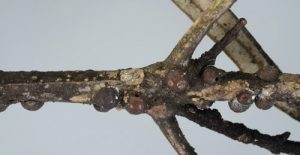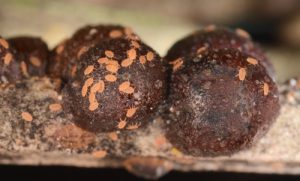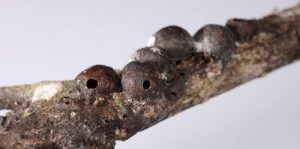Common names: black scale, black shield scale, brown olive scale, Mediterranean black scale, olive soft scale, olive brown scale.
Thought to have originated in South Africa, the black scale (Saissetia oleae) is an important pest on a variety of agronomic crops such as citrus, olive, apricot, avocado, and other tropical fruit plants, as well as ornamentals like hibiscus and oleander. A member of the soft scale family (Hemiptera: Coccidae), it was likely introduced to the United States as many destructive insect pests are, through the ornamental nursery trade.

These scale insects inflict detriment on their plant hosts while sap feeding, debilitating a plants health and causing dieback and wilting over time. As they continue feeding, a honeydew like substance is excreted at the feeding site. This honeydew serves as an excellent substrate for plant pathogens such as sooty mold growth to develop. Although this black fungus is not harmful to humans, it can inhibit a plant’s ability to properly photosynthesize leading to overall reductions in both market value and aesthetic quality.

Here in the southeastern United States, females will lie their eggs from April to September under a hardened, waxy, shell-like structure. These females can lie up to 2,500 eggs at a time and hatch ~16 days later in the summer months and up to 6 weeks later in the cooler season.
As the eggs mature, the nymphal or “crawler” stage becomes mobile, establishing itself across leaf and stem tissue of a host plant where they will initiate feeding and undergo two molts prior to maturation into their adult life stage.
The infestation or population dynamics of this pest are highly influenced by environmental cues such as temperature, humidity, and other cultural factors such as planting architecture and overall plant health. Extended periods of high humidity and densely planted crops are favorable for outbreaks of black scale.

Biological control is has been extensively evaluated for this pest and is currently considered the primary means of management for commercial level production. The parasitoid wasps Metaphycus helvolus and Metaphycus lounsburyi (also native to South Africa) have been deployed with successful results. Still, the release of these parasitoids are used primarily to augment cultural control measures already in place, aiding in keeping populations low.
The feeding habit and physical characteristics of these pests can reduce the overall efficacy of chemical control measures. The use of pesticides on adult black scale will not work due to their waxy protective coating. Any application of chemical control measures should ideally be timed during the presence of the immature crawler stage. Still, the application of chemical controls could potentially result in killing any parasitoids or natural enemies present, take several years to prove efficacious, and may have detrimental effects on some ornamental plants.
For backyard gardeners, or situations with lower infestations, mechanical control measures in the form of high-pressure water sprays may prove effective.
Check out this EDIS article on Managing Scale Insects on Ornamental Plants and Black Scale: Saissetia oleae (oliver, 1791) (Insecta: Hemiptera: Coccoidea: Coccidae) for more information.
 0
0
